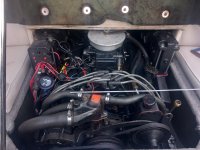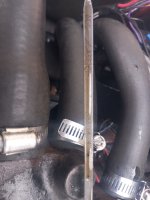Recently realised I've been reading my dipstick wrong. It has a hashed area with top-up and full marks but well above the hashed area there are 2 stamped indents / pips.
The book says the engine takes 6 quarts of oil. If I put 6 quarts in it the dipstick reads well above the hashed area and the oil level comes to the lower stamped indent. If I only put 3 quarts in it the level might come to the top of the hashed area but then the engine would only have half the oil in it that it's supposed to have.
This isn't because the pan is full of stuff or becauses I didn't pump all the oil out, I rebuilt the engine so I know it was empty before I put any oil in. After building the engine I thought I'd put 6 quarts in, checked the level and it read overfilled according to the hashed area, pumped all the oil out, refilled with 4 quarts and it was still above the hashed area but 4 quarts was the least amount of oil I dare run the engine with, so I made my own mark on the stick at 4 quarts.
Why would the dipstick be like this? Is it because it was near the end of the model line and they were scraping the parts bin?
The book says the engine takes 6 quarts of oil. If I put 6 quarts in it the dipstick reads well above the hashed area and the oil level comes to the lower stamped indent. If I only put 3 quarts in it the level might come to the top of the hashed area but then the engine would only have half the oil in it that it's supposed to have.
This isn't because the pan is full of stuff or becauses I didn't pump all the oil out, I rebuilt the engine so I know it was empty before I put any oil in. After building the engine I thought I'd put 6 quarts in, checked the level and it read overfilled according to the hashed area, pumped all the oil out, refilled with 4 quarts and it was still above the hashed area but 4 quarts was the least amount of oil I dare run the engine with, so I made my own mark on the stick at 4 quarts.
Why would the dipstick be like this? Is it because it was near the end of the model line and they were scraping the parts bin?






















